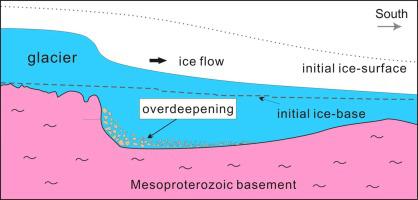当前位置:
X-MOL 学术
›
J. Asian Earth Sci.
›
论文详情
Our official English website, www.x-mol.net, welcomes your feedback! (Note: you will need to create a separate account there.)
A window into the Great Unconformity: Insights from geochemistry and geochronology of Ediacaran glaciogenic rocks in the North China Craton
Journal of Asian Earth Sciences ( IF 3 ) Pub Date : 2020-06-01 , DOI: 10.1016/j.jseaes.2020.104327 Meng Li , Thomas Matthew Vandyk , Guanghui Wu , Wei Liu , Daniel Paul Le Heron , Yang Xiao
Journal of Asian Earth Sciences ( IF 3 ) Pub Date : 2020-06-01 , DOI: 10.1016/j.jseaes.2020.104327 Meng Li , Thomas Matthew Vandyk , Guanghui Wu , Wei Liu , Daniel Paul Le Heron , Yang Xiao

|
Abstract The “Great Unconformity” across the Proterozoic-Phanerozoic boundary has long been recognised as critical for understandings of the Cambrian Explosion and changes in sediment preservation. However in many parts of the Earth no rock strata are preserved for hundreds of millions of years leading up to the Cambrian Period. This study reports detrital zircon age and whole rock geochemical data from 43 samples of glaciogenic rocks in the Ediacaran Luoquan and Dongpo Formations. Detrital zircon age populations show a distinct peak at ca. 2.5 Ga and minor peaks at 2.2–1.6 Ga, typical of Mesoproterozoic provenance. It has been established that glaciogenic strata are uniquely suited as a proxy for the average upper continental crust (UCC). Applying this principle, the samples presented herein are used to provide insights into the UCC present in the North China Craton (NCC) during the Great Unconformity. This reveals UCC older than the Neoproterozoic but younger than the Great Oxygenation Event. Based upon these findings a tectonic and climatic model is proposed, using a modern analogue from Antarctica, wherein accommodation space was created by glacial abrasion whilst uplift continued throughout the NCC. This overdeepening process provides an explanation for the preservation of these glaciogenic strata, despite the Great Unconformity that surrounds them on all sides and this study contribute towards understanding of processes in the NCC during a critical time when little has survived into the rock record.
中文翻译:

大不整合面之窗:华北克拉通埃迪卡拉纪冰川岩的地球化学和地质年代学见解
摘要 元古界-显生界边界的“大不整合”长期以来被认为是理解寒武纪大爆发和沉积物保存变化的关键。然而,在地球的许多地方,在寒武纪之前的数亿年里,没有岩层被保存下来。本研究报告了埃迪卡拉纪罗泉组和东坡组 43 个冰川岩样品的碎屑锆石年龄和全岩地球化学数据。碎屑锆石年龄群在约 2.5 Ga 和 2.2-1.6 Ga 的小峰,典型的中元古代物源。已经确定,成冰地层特别适合作为平均上大陆地壳 (UCC) 的代表。运用这一原则,本文提供的样本用于深入了解大不整合期间华北克拉通 (NCC) 中存在的 UCC。这揭示了 UCC 比新元古代更古老,但比大氧化事件更年轻。基于这些发现,提出了一个构造和气候模型,使用来自南极洲的现代模拟,其中住宿空间是由冰川磨损创造的,同时整个 NCC 持续隆起。这种过度加深的过程为这些成冰地层的保存提供了解释,尽管它们的四周都存在大不整合面,并且这项研究有助于了解在岩石记录中几乎没有幸存下来的关键时期 NCC 中的过程。这揭示了 UCC 比新元古代更古老,但比大氧化事件更年轻。基于这些发现,提出了一个构造和气候模型,使用来自南极洲的现代模拟,其中住宿空间是由冰川磨损创造的,同时整个 NCC 持续隆起。这种过度加深的过程为这些成冰地层的保存提供了解释,尽管它们的四周都存在大不整合面,并且这项研究有助于了解在岩石记录中几乎没有幸存下来的关键时期 NCC 中的过程。这揭示了 UCC 比新元古代更古老,但比大氧化事件更年轻。基于这些发现,提出了一个构造和气候模型,使用来自南极洲的现代模拟,其中住宿空间是由冰川磨损创造的,同时整个 NCC 持续隆起。这种过度加深的过程为这些成冰地层的保存提供了解释,尽管它们的四周都存在大不整合面,并且这项研究有助于了解在岩石记录中几乎没有幸存下来的关键时期 NCC 中的过程。其中住宿空间是由冰川磨损创造的,而整个 NCC 持续隆起。这种过度加深的过程为这些成冰地层的保存提供了解释,尽管它们的四周都存在大不整合面,并且这项研究有助于了解在岩石记录中几乎没有幸存下来的关键时期 NCC 中的过程。其中住宿空间是由冰川磨损创造的,而整个 NCC 持续隆起。这种过度加深的过程为这些成冰地层的保存提供了解释,尽管它们的四周都存在大不整合面,并且这项研究有助于了解在岩石记录中几乎没有幸存下来的关键时期 NCC 中的过程。
更新日期:2020-06-01
中文翻译:

大不整合面之窗:华北克拉通埃迪卡拉纪冰川岩的地球化学和地质年代学见解
摘要 元古界-显生界边界的“大不整合”长期以来被认为是理解寒武纪大爆发和沉积物保存变化的关键。然而,在地球的许多地方,在寒武纪之前的数亿年里,没有岩层被保存下来。本研究报告了埃迪卡拉纪罗泉组和东坡组 43 个冰川岩样品的碎屑锆石年龄和全岩地球化学数据。碎屑锆石年龄群在约 2.5 Ga 和 2.2-1.6 Ga 的小峰,典型的中元古代物源。已经确定,成冰地层特别适合作为平均上大陆地壳 (UCC) 的代表。运用这一原则,本文提供的样本用于深入了解大不整合期间华北克拉通 (NCC) 中存在的 UCC。这揭示了 UCC 比新元古代更古老,但比大氧化事件更年轻。基于这些发现,提出了一个构造和气候模型,使用来自南极洲的现代模拟,其中住宿空间是由冰川磨损创造的,同时整个 NCC 持续隆起。这种过度加深的过程为这些成冰地层的保存提供了解释,尽管它们的四周都存在大不整合面,并且这项研究有助于了解在岩石记录中几乎没有幸存下来的关键时期 NCC 中的过程。这揭示了 UCC 比新元古代更古老,但比大氧化事件更年轻。基于这些发现,提出了一个构造和气候模型,使用来自南极洲的现代模拟,其中住宿空间是由冰川磨损创造的,同时整个 NCC 持续隆起。这种过度加深的过程为这些成冰地层的保存提供了解释,尽管它们的四周都存在大不整合面,并且这项研究有助于了解在岩石记录中几乎没有幸存下来的关键时期 NCC 中的过程。这揭示了 UCC 比新元古代更古老,但比大氧化事件更年轻。基于这些发现,提出了一个构造和气候模型,使用来自南极洲的现代模拟,其中住宿空间是由冰川磨损创造的,同时整个 NCC 持续隆起。这种过度加深的过程为这些成冰地层的保存提供了解释,尽管它们的四周都存在大不整合面,并且这项研究有助于了解在岩石记录中几乎没有幸存下来的关键时期 NCC 中的过程。其中住宿空间是由冰川磨损创造的,而整个 NCC 持续隆起。这种过度加深的过程为这些成冰地层的保存提供了解释,尽管它们的四周都存在大不整合面,并且这项研究有助于了解在岩石记录中几乎没有幸存下来的关键时期 NCC 中的过程。其中住宿空间是由冰川磨损创造的,而整个 NCC 持续隆起。这种过度加深的过程为这些成冰地层的保存提供了解释,尽管它们的四周都存在大不整合面,并且这项研究有助于了解在岩石记录中几乎没有幸存下来的关键时期 NCC 中的过程。



























 京公网安备 11010802027423号
京公网安备 11010802027423号